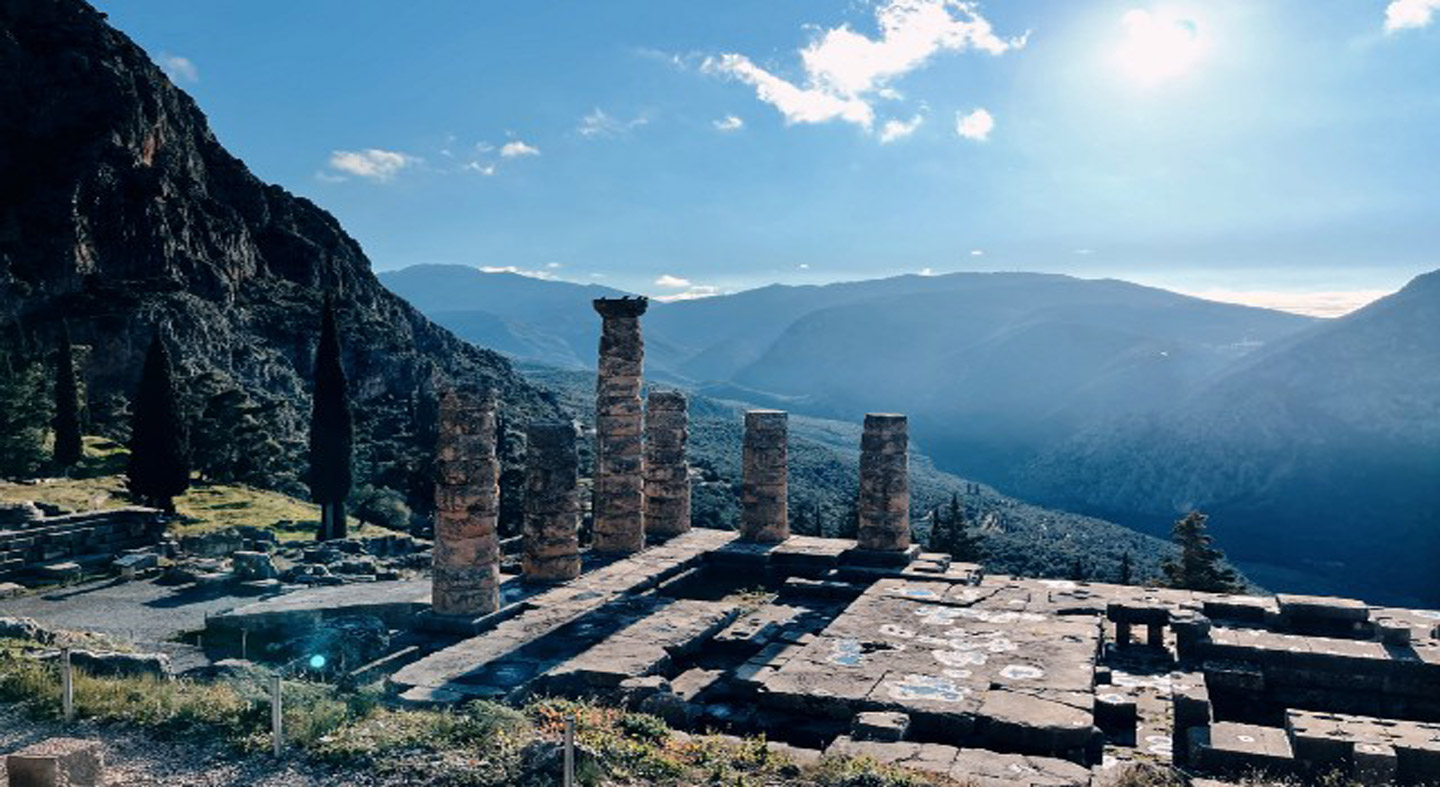
Ancient and Modern Storytelling
Greece: The Histories, the Stories, the Journey
Follow Linfield students on their 2023 Jan Term journey through Greece and Italy.


Ancient and Modern Storytelling
Follow Linfield students on their 2023 Jan Term journey through Greece and Italy.

This post originally published on Medium by Kelsey Jordan '23 with photo and outlining collaboration from Katelynn Harris '23 and Rachel McCann '25 during the 2023 January Term course through Greece and Italy ( (THTR/JAMS 398).
As the Linfield blogging team found out, perhaps the best time to visit the enduring civilization of Greece is in the off-season month of January.
After flying from Portland to Seattle, Seattle to Amsterdam and Amsterdam to Athens, one of the first things that everyone noticed when walking the streets of Greece was: cats.
Cats everywhere.
There is something simultaneously extraordinary and adorable about walking by a ruin that is two and a half millennia old and seeing a stray cat stretched over it, napping in the sun.
 And this is exactly what the blog team saw. On our first day in Athens, we were brought on a six-hour guided walking tour of the Agora, the Acropolis and the Acropolis Museum.
And this is exactly what the blog team saw. On our first day in Athens, we were brought on a six-hour guided walking tour of the Agora, the Acropolis and the Acropolis Museum.
As he led us through the Athenian Agora, he painted pictures with his words of the ancient Athenians who dwelt there in centuries past.
The Agora was the focal point of life in the ancient civilization of Athens. During the Panathenaea – an ancient religious festival in Athens – the Athenians would travel in extravagant procession up the Panathenaic Way, a wide road that weaved through the heart of the Agora, and all the way up to the Acropolis. They would carry offerings, food and a new dress for the statue of Athena while she kept her keen eyes on the city from the Parthenon.
Perhaps the most relevant topic that was discussed was the fact that the Athenian Agora was the birthplace of democracy.
The people of Athens had a duty to independently and individually vote on new laws, and once ratified, these laws would be posted at The Monument of the Eponymous Heroes. On this monument stood bronze statues of mythical heroes, each representing one of ten Athenian tribes. Beneath these staunch heroes were wooden planks on which the laws of that tribe were posted once voted into law.
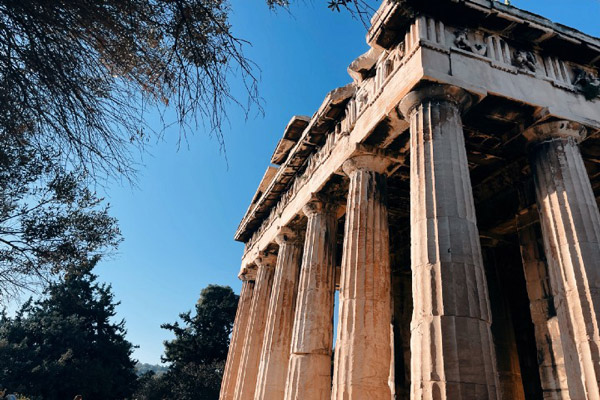 Also featured in the Agora is the surprisingly preserved Temple of Hephaestus, the Stoa, the Temple of Ares, and the house of Simon (who was, in fact, Socrates’ BFF. Socrates would come every day to hang out and chat with his best buddy Simon who lived at the front of the Agora).
Also featured in the Agora is the surprisingly preserved Temple of Hephaestus, the Stoa, the Temple of Ares, and the house of Simon (who was, in fact, Socrates’ BFF. Socrates would come every day to hang out and chat with his best buddy Simon who lived at the front of the Agora).
Once we left the Agora and entered the famed Acropolis, we witnessed not only the building that is arguably the most famous in Greece, the Parthenon, but also the Erechtheoin, a temple named after Erechtheus, the mythical king of Athens. Attached to the Erechteoin is the Temple of Poseidon which famously features a hole in both the roof and the floor.
According to myth, as Athena and Poseidon were contending for patronship over Athens, Poseidon struck his trident through the top of the building and into the ground where he caused a great fountain to erupt from the earth.
She placed the tip of her spear on the ground outside of the temple and there grew an olive tree. Athena won the people over with this offering, and thus the city was named Athens. Olive trees sprouted everywhere under the goddess’s grace.
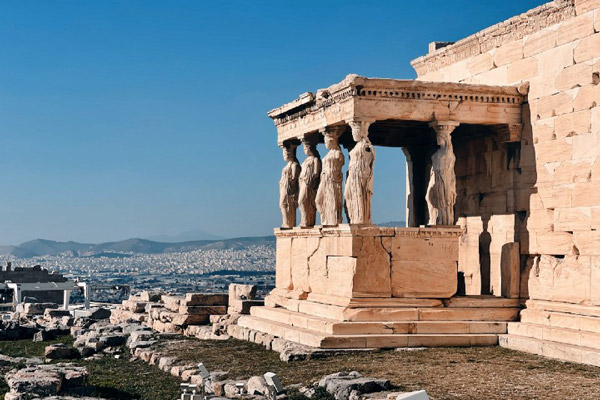 At the end of our tour we arrived at the Acropolis Museum.
At the end of our tour we arrived at the Acropolis Museum.This museum was built with two unique features.
It stands on massive concrete pillars that hold it over ancient ruins. Because of this, large patches of the floor are translucent so you can see the foundations of the buildings that stood in eras before. The museum’s other defining feature is the fact that it was built to model the Parthenon.
The bottom floor features items from the towns outside of the Acropolis, and as you travel up a ramp you get to the outside of the Parthenon which used to be lavishly decorated with hundreds of statues. As you travel floor by floor, you move up to the very top of the Parthenon on the highest floor.
Before we traveled outside of the capital city, we also went to the National Archeological Museum of Athens where (pay attention, there’s foreshadowing here) we saw the golden Death Mask of Agamemnon.
In Corinth we stood briefly over the astounding depths of the Corinth Canal before proceeding to Mycenae where we stopped at the mountain-topped castle of Agamemnon (remember that mask?).
Now, there is no actual historical record of a Mycenaean King by the name of Agamemnon who participated in the Trojan War, but Agamemnon is one of the more prominent figures of Greek mythology. Created by the play writer Aeschylus, Agamemnon features prominently in the trilogy of plays called The Orestia, including Agamemnon, Libation-Bearers and The Eumenides.
Though (spoiler alert) Agamemnon was dead by the time The Eumenides took place, his complicated legacy is one of the driving forces of the plights of his son Orestes who is the leading man of this final play.
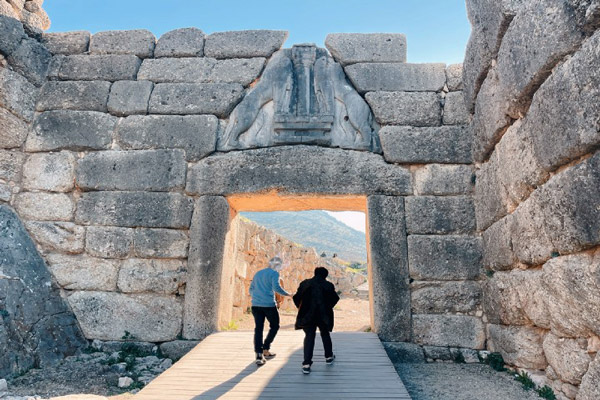 Allow me to give you a brief summary of the complicated life, controversial death and remarkable times of this Mycenaean king.
Allow me to give you a brief summary of the complicated life, controversial death and remarkable times of this Mycenaean king.
According to the story, Agamemnon lead the Greek forces in the Trojan War. But, before he left, Calchas the Seer told Agamemnon that he must kill his eldest daughter, Iphigenia, to appease Artemis as he had angered the goddess by hunting a deer on sacred land. Agamemnon, seemingly with little remorse, sacrificed his daughter.
Unsurprisingly, these actions were not taken lightly by his wife, Clytemnestra.
Immediately after Iphigenia’s tragic death, he left for a decade to fight in the war and when he returned he brought with him a forced mistress, Cassandra. As the years between them stretched, Clytemnestra’s anguish turned to hatred, and her hatred was left to seethe, deepen and grow. Cassandra, cursed by Apollo to foretell accurate prophecies but never to be believed, attempted to warn Agamemnon of his impending doom by the hand of his wife.
But, of course, he dismissed her warnings.
Enraged by her daughter’s murder and her husband’s blatant infidelity, Clytemnestra laid in wait. Agamemnon returned from the war victorious and great celebrations ensued. As night darkened the horizon and the Mycenaean king returned to his palace to bathe, Clytemnestra wielded in one hand a tablecloth and the other a dagger. Caught unaware in his peaceful bath, Agamemnon was entangled in the cloth, giving Clytemnestra the time she needed to overpower him and take her revenge.
In the next plays including Libation-Bearers and The Eumenides, Orestes, as the only son of Clytemnestra and Agamemnon, continued this cycle of violent delights and revenge.
Apollo came to Orestes in his exile and told the young man that Clytemnestra was unworthy of ruling as Queen due to the slaying of her husband, and it was up to Orestes to right this egregious wrong. Orestes returned to Mycenae where he murdered his mother, but this slaying was in gross violation of the moral backbone of Grecian values.
Such an act drew the wrathful gaze of the Furies, three gorgon-like goddesses of retribution said to have brutal eyes dripping with blood and snakes coiling and hissing in their hair. The Furies pursued Orestes relentlessly, following him to Delphi where he begged Apollo to protect him.
Athena took pity on the young man, instructing him to travel to Athens where he would be judged fairly by a jury of the Athenian people to whom he would plead his case.
In the end, this story was the first recorded case of trial by jury, and after much deliberation, Athena was forced to act as judge to break the tie between those who thought Orestes innocent, and those who condemned him. He was acquitted of wrongdoing, but it is up to you to decide: was Orestes justified in his actions? Who is really to blame for this violent cycle?
The genius of its architects showed in the designs of this structure as, without the use of microphones or any device, one can hear a coin drop on the stage from the top row of the theatre. We tested it, and it’s absolutely true.
Then we spent the night in the port city of Nafplion where a great fortress keeps vigil almost one thousand steps above the small city.
In Delphi, we found the remains of the Temple of Apollo where Orestes took to his knees in desperation. While very little remains of what was once an expansive center of life, it does not take much to turn one’s mind back millennia and imagine the treasury, the temple, the gymnasium and all of the ancient peoples living their lives and going about their business in the once shining structures.
Though our endings were much less judicial, we found ourselves both excited to continue our journey to Italy, and sorrowful to leave the rich culture, kind people, and of course, the many cats that we found in our odyssey of mainland Greece.
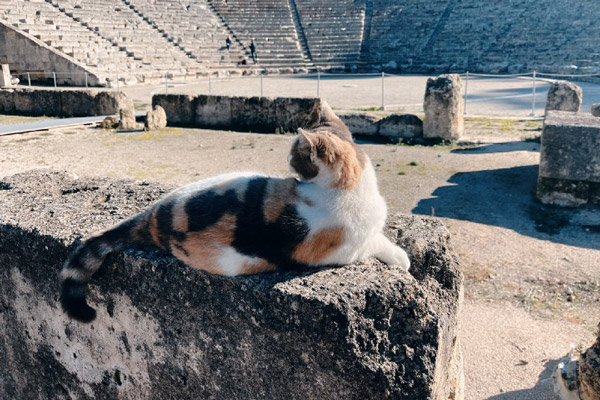
Stray cat napping on the stage of the theatre at the Asclepieion in Epidaurus.
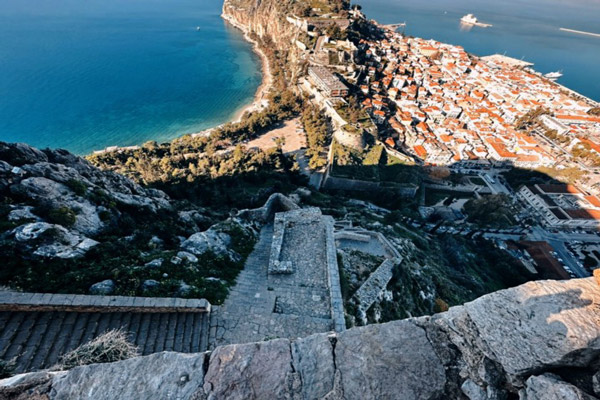
The steps leading up to Nafplion’s Fortress.
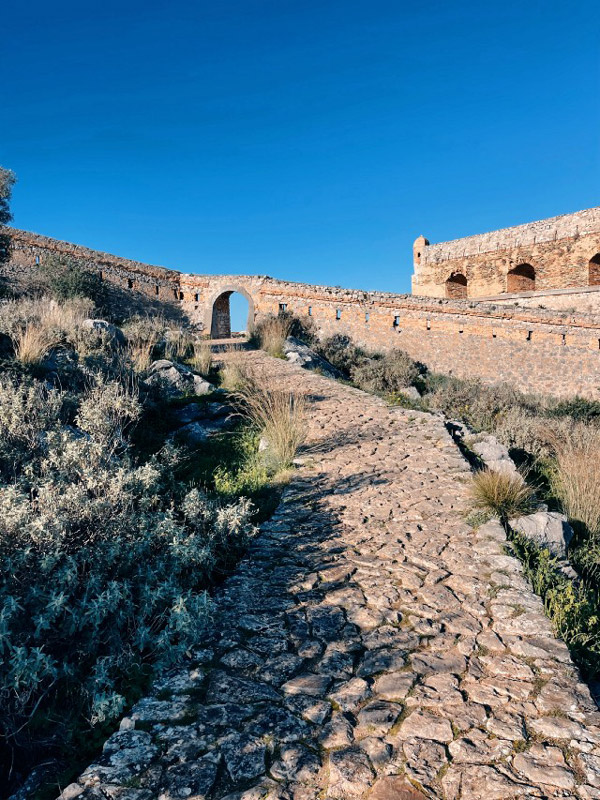
The outer wall of Nafplion's Fortress.
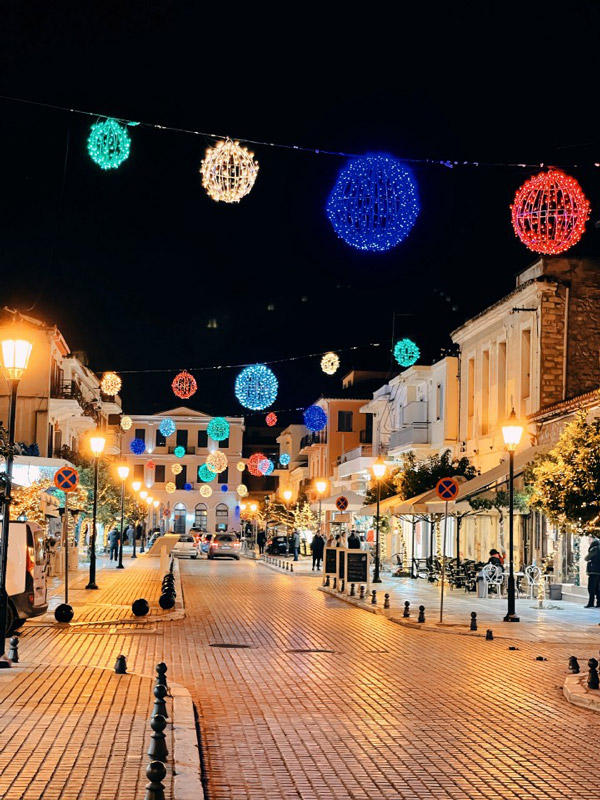
Nafplion Street at night still decorated for the holidays.
To hear more of the students' Jan Term journey through Greece and Italy, tune into Spotify!